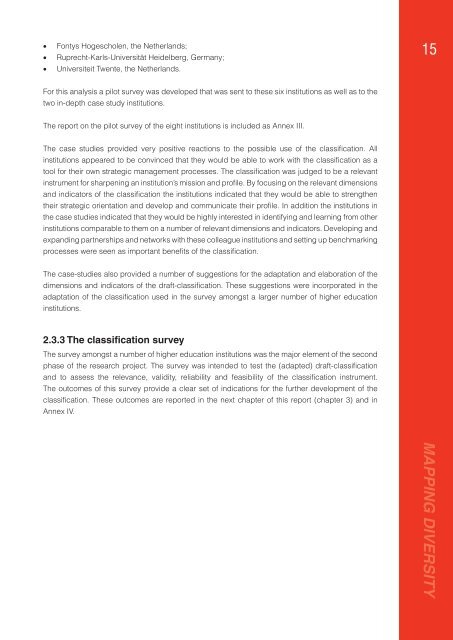Mapping Diversity: Developing a European Classification of ... - U-Map
Mapping Diversity: Developing a European Classification of ... - U-Map
Mapping Diversity: Developing a European Classification of ... - U-Map
Create successful ePaper yourself
Turn your PDF publications into a flip-book with our unique Google optimized e-Paper software.
• Fontys Hogescholen, the Netherlands;<br />
• Ruprecht-Karls-Universität Heidelberg, Germany;<br />
• Universiteit Twente, the Netherlands.<br />
15<br />
For this analysis a pilot survey was developed that was sent to these six institutions as well as to the<br />
two in-depth case study institutions.<br />
The report on the pilot survey <strong>of</strong> the eight institutions is included as Annex III.<br />
The case studies provided very positive reactions to the possible use <strong>of</strong> the classifi cation. All<br />
institutions appeared to be convinced that they would be able to work with the classifi cation as a<br />
tool for their own strategic management processes. The classifi cation was judged to be a relevant<br />
instrument for sharpening an institution’s mission and pr<strong>of</strong>i le. By focusing on the relevant dimensions<br />
and indicators <strong>of</strong> the classifi cation the institutions indicated that they would be able to strengthen<br />
their strategic orientation and develop and communicate their pr<strong>of</strong>i le. In addition the institutions in<br />
the case studies indicated that they would be highly interested in identifying and learning from other<br />
institutions comparable to them on a number <strong>of</strong> relevant dimensions and indicators. <strong>Developing</strong> and<br />
expanding partnerships and networks with these colleague institutions and setting up benchmarking<br />
processes were seen as important benefi ts <strong>of</strong> the classifi cation.<br />
The case-studies also provided a number <strong>of</strong> suggestions for the adaptation and elaboration <strong>of</strong> the<br />
dimensions and indicators <strong>of</strong> the draft-classifi cation. These suggestions were incorporated in the<br />
adaptation <strong>of</strong> the classifi cation used in the survey amongst a larger number <strong>of</strong> higher education<br />
institutions.<br />
2.3.3 The classification survey<br />
The survey amongst a number <strong>of</strong> higher education institutions was the major element <strong>of</strong> the second<br />
phase <strong>of</strong> the research project. The survey was intended to test the (adapted) draft-classifi cation<br />
and to assess the relevance, validity, reliability and feasibility <strong>of</strong> the classifi cation instrument.<br />
The outcomes <strong>of</strong> this survey provide a clear set <strong>of</strong> indications for the further development <strong>of</strong> the<br />
classifi cation. These outcomes are reported in the next chapter <strong>of</strong> this report (chapter 3) and in<br />
Annex IV.<br />
MAPPING DIVERSITY

















